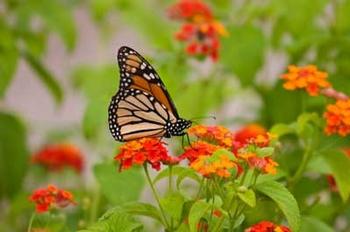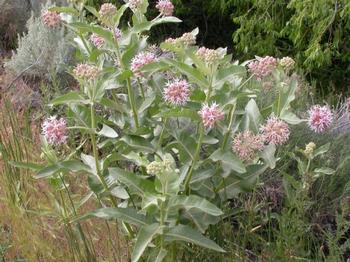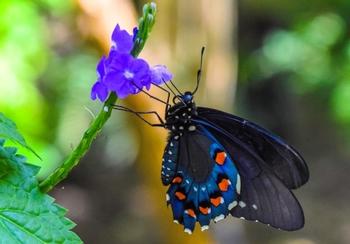Bring on the butterflies
-
Butterflies and moths dance from one flower to another in our gardens, drinking nectar with their long slender proboscis. A bit of pollen sticks to the proboscis and is transferred to the female part of another flower.
 A monarch butterfly visits a patch of orange lantana Photo: Jill Lang
A monarch butterfly visits a patch of orange lantana Photo: Jill LangOver 230 types of butterflies live in California. The Butterflies and Moths of Northern America (BAMONA) database currently includes verified sighting records for 161 species in Marin County.
Butterflies feed on the nectar of flowers. A beautiful, abundant flower garden can be Sunday brunch at the Ritz for a butterfly.
How to attract butterflies into the garden
Butterflies need food, water, and shelter to survive, but each type prefers a different food source so they don’t compete with each other. Home gardeners can encourage butterflies by providing blooming plants, resting places, and damp spots.
Food: aim for year-round flowers
Grow nectar plants for butterflies in anything from window boxes and flowerpots to large meadows. Aim to provide blooming plants throughout the year so wandering butterflies can snack in your garden. While some butterfly species are attracted to specific types of plants, most are general feeders. Butterflies are attracted to flowers planted in groups.
Water: keep it shallow
Butterflies cannot drink from open water. A good way to provide drinking water for butterflies is to place a pan of wet sand in an open area. Check it regularly to be sure it stays moist. Butterflies can also drink from drops of morning mist or dew on plant leaves.
Shelter: rocks and trees provide protection
Butterflies appreciate a place out of the wind where they can sun themselves or hide from strong sunlight and birds. Large rocks in open areas are welcome spots for resting butterflies. Some prefer the sunny surface of a fence. Other butterflies prefer to rest inside trees where they are shaded and protected from birds.
Life cycle of a butterfly
Butterflies lay eggs on selected favorite plants that are usually different from the ones the adults feed on. Egg hatch and larva development is timed to match host plant growth. Larva (caterpillar) growth is different for different types of butterflies and can take only a few weeks or as long as two or more years. When old enough, larvae leave the feeding area and begin a process called metamorphosis, changing from inside of a hard or leathery case called a pupa or chrysalis. Pupae may be found in the soil, on plants, or in garden debris. After an appropriate time, the adult butterfly emerges from the pupa, pumps up its wings, and flies off to seek a mate, find blooming plants, and seek out a place to lay eggs.
Butterflies prefer (and need) California native plants
Milkweed, Asclepias speciosa or Asclepias fascicularis, is especially attractive to butterflies. This low-maintenance plant has showy flowers rich in nectar. As an added bonus, butterflies that feed on this and other native milkweeds acquire chemical protection from predators. Unfortunately, non-native milkweeds can have the opposite effect, exposing vulnerable butterflies to predation. Monarch caterpillars only eat milkweed plants and monarch butterflies need milkweed to lay their eggs. Monarchs must have milkweed to survive. Photo: Wikimedia commons
Monarchs must have milkweed to survive. Photo: Wikimedia commonsLike milkweed, the very best plants for butterflies are California native plants. Since the plant and butterfly species evolved together, native plants naturally support native butterflies by providing both the nectar they need to thrive and the larval plant host they need for laying their eggs. Butterflies are particular about where they lay their eggs as the caterpillars can eat only certain plants. Other California native plants that butterflies adore include buckwheat, coyote mint, California lilac (ceanothus), asters, hummingbird sage, yarrow, lavatera, lupine, manzanita, and California buckeye.
Non-native favorites include lantana, pincushion flower, coneflower species, pineapple guava, cranesbill geranium, and butterfly bush. The beautiful Cecile Brunner rose actually acts as a host plant for butterfly species.
Here's more on choosing plants.
Is it a pipevine swallowtail or a copycat? Pipevine swallowtail feasting on nectar Photo: Charles Patrick Ewing, Flickr
Pipevine swallowtail feasting on nectar Photo: Charles Patrick Ewing, FlickrAn interesting butterfly you can attract to your garden is the pipevine swallowtail, Battus philenor. As the name suggests, these butterflies lay their eggs only on the undersides of leaves on members of the pipevine family, such as the California Dutchman’s pipevine, Aristolochia californica, and Virginia snakeroot, Aristolochia serpentaria.
As with the monarchs and milkweed, when the larval caterpillars consume the native pipevine, a chemical in the plant makes the caterpillars poisonous to birds and so birds naturally avoid them. Other butterflies have evolved to mimic their size and coloring so that they too will be protected from hungry birds. In fact, the pipevine swallowtail can be difficult to identify because several other butterflies are very similar in appearance.
Original text by Juliana Jensen, Dean Donaldson, V. Fish, and P. Pawl
Edited by Jane Scurich for the Leaflet



